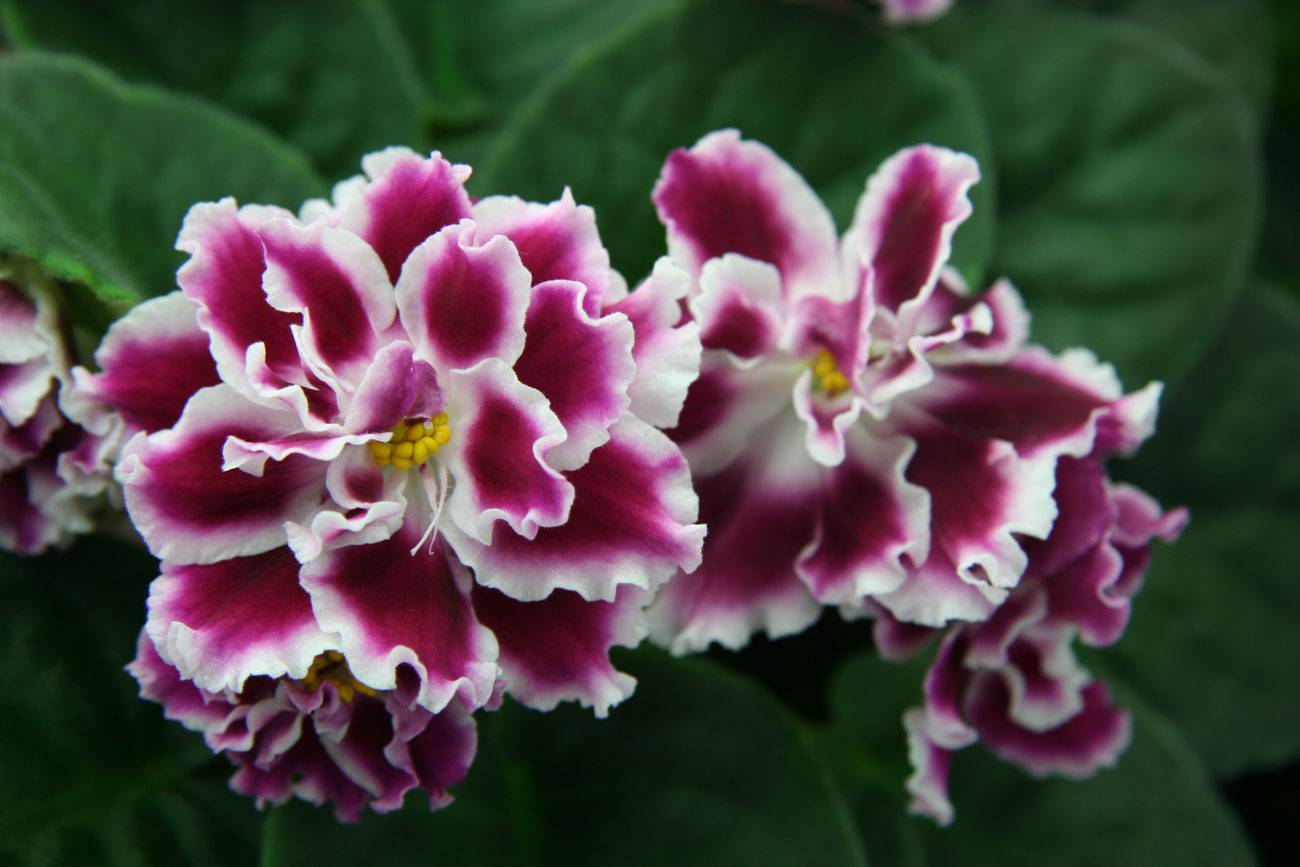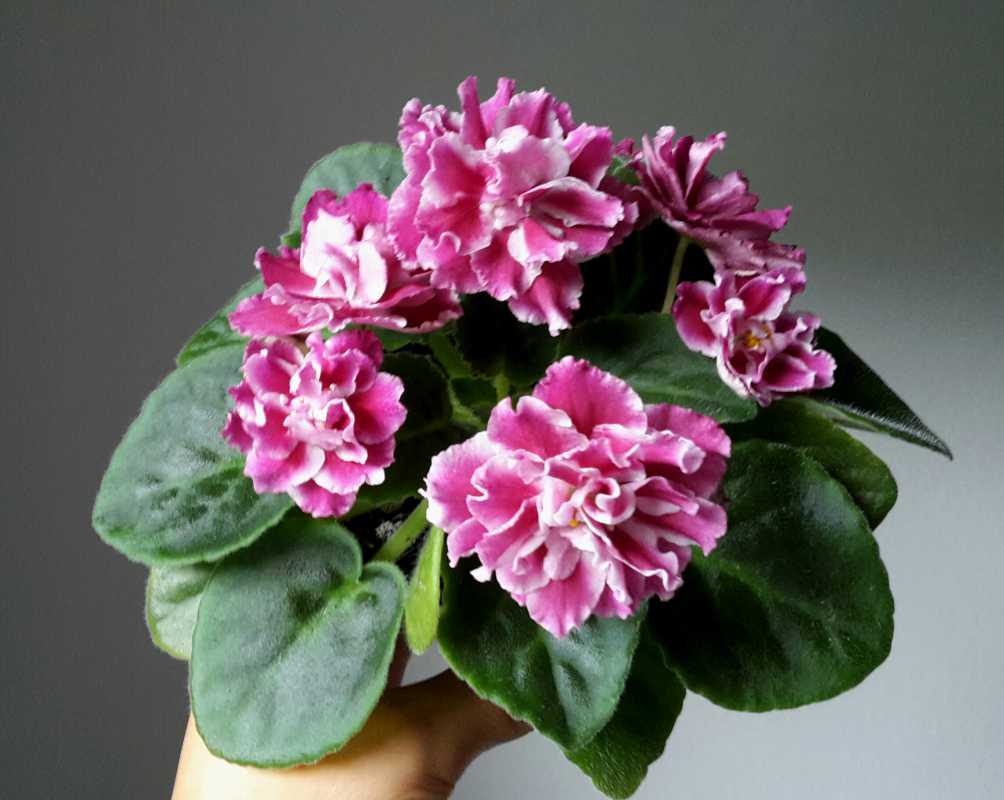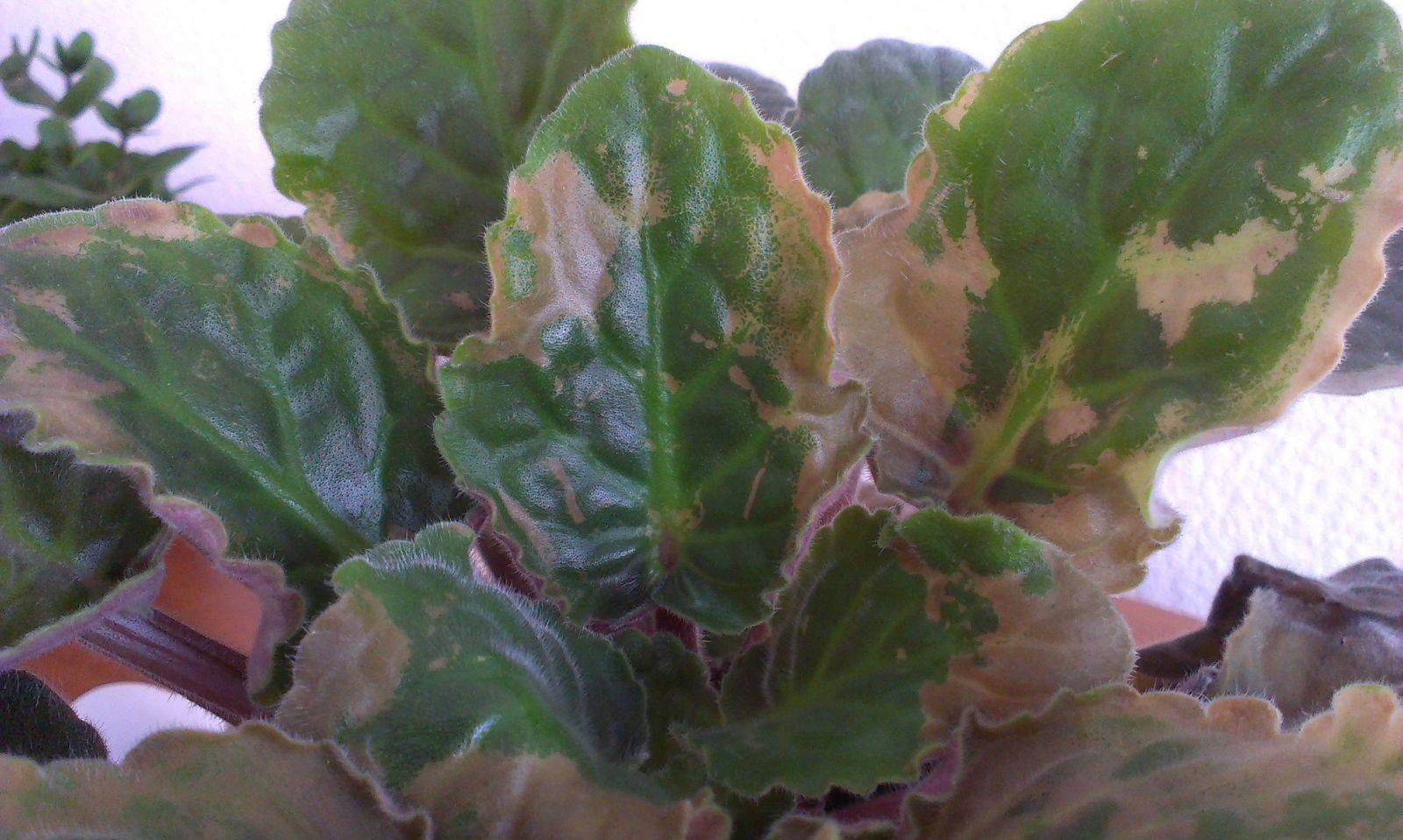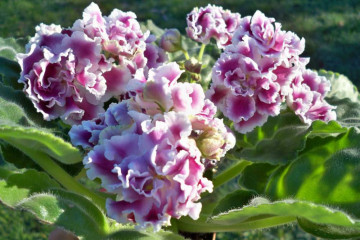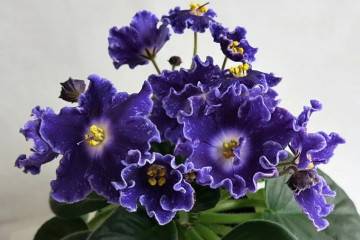Violet Frosty cherry - description and characteristics of the variety
Content:
Delightful novelties from the collection of the famous Russian breeder K.L. Morev are the object of interest of many fans of Uzambar violets. The Frosty Cherry variety, which he recently developed, will become the pearl of any Saintpaulia collection.
What does a violet Frosty cherry look like: description
It is a semi-double variety with juicy cherry-colored petals with a white or pale pink border and pleasant, even green leaves. The socket is standard size and compact.
Plant characteristics
Violet is interesting primarily for its unusually lush and beautiful flowers. The diameter of the corolla reaches 4 cm. The petals are collected in a semi-double flower, in the center of which large yellow stamens are hidden. The edges of each petal have an even or wavy border of white or pink, and the central cherry spot is a noticeable overflow from light to dark.
The leaf is velvety with a noticeable pile, it is green, elongated, heart-shaped. The surface has a matte sheen, in places of veins it bulges, which creates the effect of a quilt. The petioles are long and pubescent. The root system is standard for Saintpaulias - branched, superficial.
A prominent Russian breeder K. Morev was engaged in the development of the Frosty Cherry variety for at least 10 years. Today it can be purchased in specialized stores throughout the country and abroad.
Differences from the EK-Winter cherry variety
A violet with a similar name, bred by the breeder E. Korshunova, demonstrates some similarity with the original cultivar by K. Morev. But two flowers are similar only at first glance, there are quite a few differences between them. Violet Winter Korshunova cherry has less double flowers with a diameter of not 4, but 7 cm. The rim of a light pink hue along the edge of the petals is very narrow and sometimes almost invisible, and the middle of a thicker, purple, cherry tone. The leaf is larger and darker in color. In a word, it is impossible to confuse the sockets standing nearby, although both are magnificent.
Features of caring for a violet Frosty cherry at home
For those who already have Saintpaulias on their windowsill, it will not be difficult for Frosty Cherry to provide the required conditions after purchase.
Temperature
The optimum temperature throughout the year is in the range from 20 ° C to 25 ° C. With a decrease to 20 ° C, the rosette will grow more slowly, and with an increase above 25 ° C, there is a risk of death.
Lighting
Violets need bright, but diffused lighting throughout the year. If the flower pot is placed on a windowsill, then a north or east window is ideal.
If there is no suitable window, then the flower can be kept under a regular fluorescent lamp. The optimal distance between the lamp and the flower is 25-30 cm. The recommended duration of daylight hours is 8-10 hours.
Watering
Saintpaulias are very hygrophilous, but the irrigation regime is quite strict. The soil is moistened only through the bottom of the pot, pouring water into the pan. It is for this reason that the pot must be bought with large drainage holes. Re-watered when the soil on the surface dries out.
Spraying
It is impossible to spray violets on a leaf. Water droplets leave unsightly spots on the leaf plates and can cause the development of fungal diseases.
Humidity
Saintpaulias are very fond of humid air. If the humidity in the room is below 60%, then it is very useful for the flower to be near a container of water. You can put the pot in 2 trays, filling the lower one with water, or choose a place for it next to the aquarium.
Priming
Since the Violet Cherry is a fast growing and profusely blooming indoor flower, it needs a very fertile soil with a high humus content. It is easy to distinguish a good store soil from a poor-quality one - a suitable color is black, and a nutrient-poor one is brown.
The planting substrate is prepared independently. The basis is a store-bought primer for violets. Baking powder must be added to it: vermiculite, charcoal, coarse sand.
Top dressing
Immediately after transplanting, Cherry does not need feeding for 3 weeks, there are enough nutrients in the soil. Then, with each watering, add the complex mineral fertilizer recommended for violets, diluted 3-4 times thinner than the manufacturer recommends. With this care, flowering will come on time and will be more abundant.
When and how it blooms
Traditionally, Uzambara violets bloom most profusely in spring, winter and autumn. Depending on age and care, year-round flowering can be achieved. Forcing new peduncles with a constant supply of nutrients occurs at intervals of 2-3 months, but the buds do not bloom all at once, but gradually, one at a time.
Types of flowers
Adult frost cherry plants usually have flowers that differ slightly from each other only in size. However, when the conditions of the plant are changed, the color of the petals may change. If the air temperature rises, then the flowers darken, and when the snap gets cold, they brighten, their light border becomes wider.
Flower shapes
Corolla of Saintpaulia Frosty cherry semi-double. The core of the flower is surrounded by 2 rows of petals (5-7 pcs.), And another row of slightly smaller petals is grouped in the center. The edges of the petals are slightly corrugated.
Flowering period
The most important condition for the start of flowering is the temperature and light regime for 12 hours. As soon as the air cools or heats up too much, flowering stops.
Changes in care during flowering
When forcing buds, it is important to provide regular and systematic feeding with organic and mineral fertilizers. Violets need nitrogen in a minimal amount, unlike potassium and phosphorus. Fertilizers are suitable for indoor flowering plants, for example, agriculture, but the concentration is reduced by 2 times that recommended by the manufacturer, so as not to provoke an active increase in green mass to the detriment of flowering. The frequency of dressing is every 10-14 days.
How Saintpaulia reproduces Frosty cherry Moreva
All Saintpaulias easily reproduce vegetatively: by a leaf and even a segment of a leaf plate, peduncles, as well as children forming at the roots. Rooting of leaves and peduncles can be carried out in water or substrate. Root formation takes an average of 4-6 weeks. But the flowers of daughter plants do not always repeat the parental color, in such cases, breeders talk about getting a sport.
Transplant after purchase and during reproduction
It is recommended to transplant the plant from the shipping container into a new pot immediately after purchase. Often in stores, flowers are in oversized pots. For an adult Saintpaulia, the maximum pot diameter is 9 cm, and even less for young ones. Young violets, formed from a leaf or peduncle, must be planted in individual pots with a starting diameter of no more than 5 cm.When a young rosette of green mass is recruited, the next transplant occurs after 3-4 months into a pot with a diameter of 6 cm.
The soil must be mixed with disintegrants (sand, vermiculite, charcoal) in order to achieve its high air permeability. You do not need to put drainage on the bottom of the planting container, but the irrigation holes must be large.
Possible growing problems
With all the variety of forms of leaves and flowers, Saintpaulia, with improper agricultural techniques, demonstrate similar problems, which are quite possible to avoid.
Leaf problems
Soft leaves with brown or black spots on them may indicate the following care errors:
- wrong watering regime;
- too high or too low temperature;
- sunburn;
- overdose of fertilizers and, as a consequence, the defeat of fungal diseases.
The damaged leaves are removed, the plant is removed from the soil, the roots are inspected, transplanted into a fresh substrate, removed from direct sunlight and watering is reduced. Top dressing is resumed only after the turgor of the remaining leaves is completely restored. If the roots have all become lethargic and brown or black, then rejuvenation of the rosette is recommended. The entire root part is cut with a sharp knife along the trunk and the rosette is re-rooted in the substrate.
Pests
Violets can be affected by the most common pests of indoor plants: spiderweb and other types of mites, thrips, mealybugs, aphids, scabies. If dry small brown spots are found on the leaves, treatment with specialized preparations should be carried out: fitoverm, actara, and the soil should be changed to fresh.
Diseases
Common diseases of Saintpaulias are root rot that appears after the flood, as well as vascular bacteriosis - a consequence of overheating of the outlet and sunburn. Only the restoration of proper agricultural technology will help against rot, or you will have to select healthy leaves and root them. With vascular bacteriosis, the plant dies very quickly, so it is so important not to overheat.
Signs of improper care
A healthy violet has very elastic leaves with a noticeable glossy sheen of the leaf plate between the bristles on its surface. Leaves grow on rather long petioles that do not interfere with each other. Flowers appear regularly in abundance. An excessively thickened dull rosette, shrinking flowers, lethargic and too dark or unusually light leaves indicate that the agricultural technique in this case is wrong.
Frosty cherries are a magnificent variety that hundreds of collectors fell in love with at first sight. It is not difficult to grow it; in its care, the plant requires the use of standard techniques common to all Uzambara violets. The main thing is not to overheat the flower in the sun and do not flood it with water during watering.
